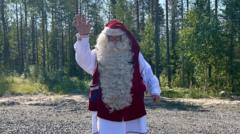As Lapland swelters under an unprecedented heatwave, Santa Claus finds himself adjusting his usual routines, reminding his elves to stay hydrated and limit outdoor activities. This summer, areas in northern Finland have faced temperatures reaching around 30 degrees Celsius for an extended period, compelling the iconic figure to adapt his customary ways.
"It’s not every day I have to remind my elves about sun safety," Santa remarked, donning his heavy red outfit, which is ill-suited for the soaring temperatures. He mentioned, "I'll only be venturing outdoors for a swim once it cools down in the evening." Although Santa’s workshop remains busy as ever in the city of Rovaniemi, the rising temperatures pose a serious challenge, with experts attributing the extreme weather to climate change.
The Finnish Meteorological Institute confirmed that Lapland is experiencing a record-breaking heatwave, having lasted 15 days as of July 25, with temperatures long exceeding 25 degrees Celsius, which is classified as a heatwave in Finland. Meteorologist Jaakko Savela noted that temperatures above 30 degrees are exceedingly rare in this region, and the current heatwave has surpassed the previous record of 12 to 14 days set in 1972.
Other locations in Lapland have followed suit, marking their longest heat events on record, with temperatures peaking at a staggering 31.7 degrees Celsius. The situation emphasizes ongoing concerns regarding climate change's accelerating effects in the Arctic, which is warming at an alarming rate, four to five times faster than the global average.
While this particular heatwave cannot be directly attributed to climate change, experts argue that its intensity has been influenced by rising global temperatures. Prof. Jeff Weller, a researcher at the University of Oulu, asserts that climate change is increasingly responsible for extreme weather patterns worldwide, including both unprecedented heat and adverse storms.
The heat is also taking a toll on Lapland's famed reindeer population. These animals, vital to Christmas lore, are retreating to human settlements seeking relief from the relentless swarms of mosquitoes that thrive in warmer weather. Given that the highest terrain in Finnish Lapland only reaches about 1,000 meters, reindeer herders may need to begin constructing shaded barns to protect their livestock from future heat extremes.
Tourists visiting Santa's village this summer are caught off guard by the oppressive warmth. One visitor from Prague expressed confusion, having expected a respite from the heat, saying, "I packed the wrong clothes for 30C weather!" Similar sentiments were echoed by other tourists, emphasizing their surprise at the uncharacteristic weather at the Arctic Circle.
As daylight stretches longer with 20-hour days in Rovaniemi, temperatures remain elevated late into the night, complicating the situation for both locals and visitors. Elina, an elf working in Santa's post office, voiced her concern about these heatwaves becoming the new normal, reflecting widespread anxiety about the future of Lapland's winters.
For Santa, the challenge remains in managing his traditional attire amidst a sweltering summer, stating, "I prefer the cold and snow. Winter is better." The unexpected rise in temperature serves as a sobering reminder of climate change's impact on even the most iconic winter wonderlands.
"It’s not every day I have to remind my elves about sun safety," Santa remarked, donning his heavy red outfit, which is ill-suited for the soaring temperatures. He mentioned, "I'll only be venturing outdoors for a swim once it cools down in the evening." Although Santa’s workshop remains busy as ever in the city of Rovaniemi, the rising temperatures pose a serious challenge, with experts attributing the extreme weather to climate change.
The Finnish Meteorological Institute confirmed that Lapland is experiencing a record-breaking heatwave, having lasted 15 days as of July 25, with temperatures long exceeding 25 degrees Celsius, which is classified as a heatwave in Finland. Meteorologist Jaakko Savela noted that temperatures above 30 degrees are exceedingly rare in this region, and the current heatwave has surpassed the previous record of 12 to 14 days set in 1972.
Other locations in Lapland have followed suit, marking their longest heat events on record, with temperatures peaking at a staggering 31.7 degrees Celsius. The situation emphasizes ongoing concerns regarding climate change's accelerating effects in the Arctic, which is warming at an alarming rate, four to five times faster than the global average.
While this particular heatwave cannot be directly attributed to climate change, experts argue that its intensity has been influenced by rising global temperatures. Prof. Jeff Weller, a researcher at the University of Oulu, asserts that climate change is increasingly responsible for extreme weather patterns worldwide, including both unprecedented heat and adverse storms.
The heat is also taking a toll on Lapland's famed reindeer population. These animals, vital to Christmas lore, are retreating to human settlements seeking relief from the relentless swarms of mosquitoes that thrive in warmer weather. Given that the highest terrain in Finnish Lapland only reaches about 1,000 meters, reindeer herders may need to begin constructing shaded barns to protect their livestock from future heat extremes.
Tourists visiting Santa's village this summer are caught off guard by the oppressive warmth. One visitor from Prague expressed confusion, having expected a respite from the heat, saying, "I packed the wrong clothes for 30C weather!" Similar sentiments were echoed by other tourists, emphasizing their surprise at the uncharacteristic weather at the Arctic Circle.
As daylight stretches longer with 20-hour days in Rovaniemi, temperatures remain elevated late into the night, complicating the situation for both locals and visitors. Elina, an elf working in Santa's post office, voiced her concern about these heatwaves becoming the new normal, reflecting widespread anxiety about the future of Lapland's winters.
For Santa, the challenge remains in managing his traditional attire amidst a sweltering summer, stating, "I prefer the cold and snow. Winter is better." The unexpected rise in temperature serves as a sobering reminder of climate change's impact on even the most iconic winter wonderlands.


















